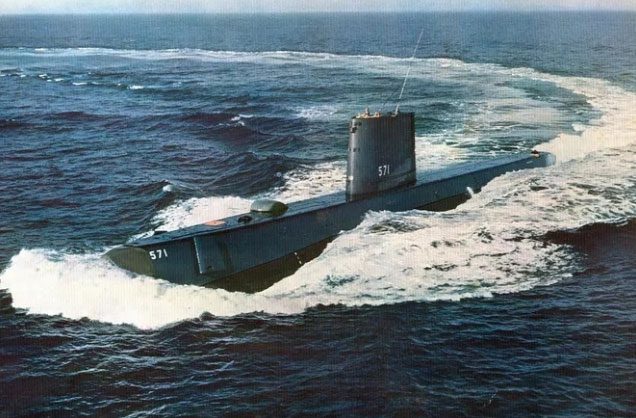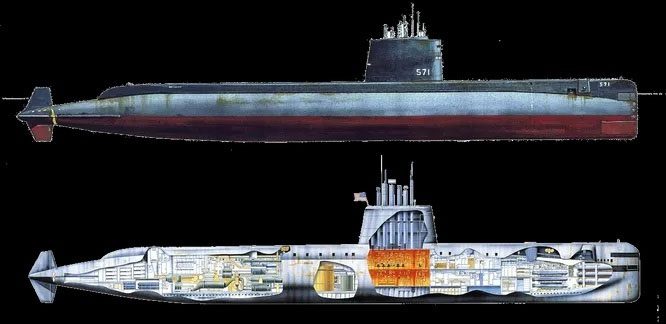Nuclear-powered submarines will help the U.S. Navy reduce the large number of supply ships at sea and decrease logistical demands on fleets.
On September 30, 1954, the U.S. Navy commissioned the world’s first nuclear submarine. This submarine, named after a fictional ship from the works of author Jules Verne, operated for a quarter of a century and became a pioneering vessel in many aspects simultaneously.

USS Nautilus is the world’s first nuclear submarine, igniting the underwater race between the U.S. and the Soviet Union.
Nuclear Submarine Developed Over Six Years
In 1948, the U.S. Navy established the Nuclear Power Branch, initiating a revolution in military submarine propulsion. In August 1949, operational data for the first nuclear submarine was approved, and the vessel was laid down on June 14, 1952, in the presence of President Harry Truman at the Groton shipyard, named Nautilus (USS Nautilus, SSN-571).
In 1954, in the presence of President Dwight Eisenhower, the Nautilus was launched and subsequently delivered to the U.S. Navy.
The Nautilus crew consisted of 13 officers and 92 sailors. The submarine was equipped with six 533 mm torpedo tubes at the bow and carried 24 torpedoes.
Heavy Yet Quite Fast
The Nautilus differed from diesel-electric submarines not only in its new power plant but also in its hull design. With a displacement of approximately 4,000 tons, the vessel was equipped with a dual-shaft nuclear power plant, the S2W model from Westinghouse Electric Corporation, with a total output of 9,860 kW (13,800 horsepower), achieving speeds of over 20 knots.
Submarine at Sea in 1955
On January 17, 1955, the Nautilus set sail for the first time, and its first captain, Eugene Wilkinson, sent a historic message: “We are operating on atomic power.”
During its service, the USS Nautilus broke numerous submarine voyage records, including a dive from New London, Connecticut, to Puerto Rico, covering 2,222 km in 90 continuous hours.
Nautilus Reached the Arctic
In August 1958, the Nautilus became the first ship in history to reach the Arctic. A year earlier, the first attempt at such a mission had failed. The submarine navigated beneath thick ice, attempting to surface but collided with a drifting iceberg, severely damaging its only periscope.
Nautilus “Too Prominent”
The design of the Nautilus had significant flaws. The weight of the nuclear reactor installation turned out to be quite substantial, which is why it was impossible to install a portion of the weaponry provided by the project on the vessel. The submarine itself weighed about 35 tons, while the biological shielding, including lead, steel, and other materials, weighed approximately 740 tons.

At that time, installing a nuclear reactor on a submarine was considered a very risky decision since even a minor error could turn the entire vessel into a massive atomic bomb.
The problem with the vessel was the noise it generated. The operating turbines created vibrations to the extent that sonar (a technique using sound propagation to navigate and communicate) became ineffective at speeds of 4 knots. The submarine became “too prominent” due to the noise it produced. This shortcoming was taken into account by the Americans when designing subsequent nuclear submarines.
Sailors Had to Search for Leaks
There were also humorous incidents in the life of the Nautilus. In May 1958, while preparing for the Arctic voyage, a leak was discovered in the main condenser of a steam turbine. Water from outside seeped into the freshwater system, potentially salting the secondary circuit and leading to a total failure of the submarine’s electrical system. Efforts to locate the source of the leak were unsuccessful, and the submarine’s commander made an initial decision.
After the Nautilus arrived in Seattle, Washington, the crew in civilian clothes purchased all the fluids from auto shops to pour into the submarine’s radiator to stop the leak. Half of this fluid (about 80 liters) was poured into the condenser, and subsequently, not in Seattle nor during the operation, the issue of salinity in the condenser arose. Perhaps, the leak was in the gap between the condensers and stopped after filling this space with a homemade hardening mixture.
Pioneering in the Mediterranean
In August 1960, the world’s first nuclear submarine was assigned to the U.S. Sixth Fleet and subsequently became the first nuclear submarine in the Mediterranean.
Nautilus Became a Museum
After 25 years of service in the U.S. Navy, with a total of 2,507 dives and over 820,000 km traveled without encountering any incidents, Nautilus proved that nuclear-powered vessels are very safe and effective, paving the way for the U.S. Navy to build a formidable fleet of nuclear submarines.
In 1980, Nautilus was honored as a symbol of American strength. The submarine was decommissioned and, in 1982, was designated a National Historic Landmark. Plans were made to convert the submarine into a publicly displayed museum. On July 6, 1985, Nautilus was exhibited at the U.S. Submarine Force Museum in Groton, Connecticut.




















































